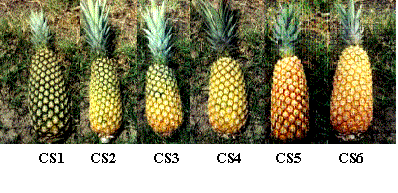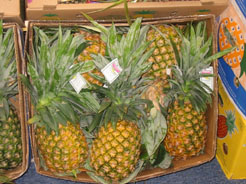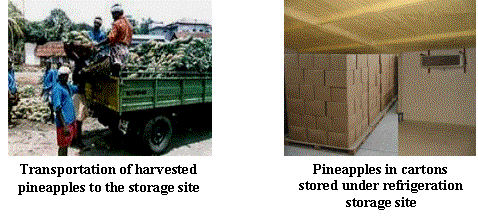|
Harvesting & Storage
Harvesting
Pineapple plants flower 10-12 months after planting and attain harvesting stage
15-18 months after planting, depending on the variety, time of planting, the type
and size of plant material used and the prevailing temperature during fruit development.
Under natural conditions, pineapple comes to harvest during May- August. With
a slight colour change at the base of developing fruit, it could be harvested for
canning purpose. But for table purpose, the fruit could be retained till it
develops satisfactory golden yellow colour. Harvesting is done with a sharp
knife, severing the fruit-stalk with a clean cut retaining 5-7 cm of stalk with
the fruit in such a way that the fruit is not damaged.
The stage of maturity at harvest is dependent on the required storage or shelf-life
and the method of transportation to the export markets. The level of yellow colouration
of the "eyes" of the fruit judges maturity.
Colour stages are categorised as follows:
CS1: all eyes green, no traces of yellow;
CS2: 5 to 20% of the eyes yellow;
CS3: 20 to 40% of the eyes yellow;
CS4: 40 to 80% of the eyes yellow;
CS5: 90% of eyes yellow, 5 to 20% reddish brown;
CS6: 20 to 100% of eyes reddish brown.

|
Sugar content should be assessed in the field prior to harvesting to ensure adequate
sugar development. A minimum of 10 % is generally required although this may vary
with the market. Sugar content is not always related to the colour stage as agronomic
and production factors will affect sugar development. For the export market where
sea-shipment for seven to fourteen days is used, fruits should be harvested at CS1,
where the fruits show no yellow colour development on the eyes (ensuring that checks
have been made on the sugar content). For airfreighted shipments, although generally
cost prohibitive, harvesting can be carried out at CS2 to CS3. Those harvested at
more advanced stages are more susceptible to mechanical damage and over-ripeness.
Fruit maturity can also be assessed on random samples by determination of the flesh
condition. This is carried out by slicing the fruit horizontally at the point of
largest diameter. In fruit for sea-shipment export the fruit should show limited
development of translucent areas. Where more than half of the area is translucent,
the fruit is considered beyond optimum maturity. Pineapples harvested by hand are
snapped from the stalk using a downward motion. The fruit should be placed in field
crates and while in the field, left in shaded conditions. Collection in the field
and field to pack house transport using sacks or bags will cause mechanical damage
and increase the level of rejection. On arrival at the packing facility, the stems
and the crowns should be trimmed to 2 cm (0.5") and 10 cm (4") respectively.
Out grading should be made of all fruits which are undersize, oversize, over-ripe,
under-ripe (depending on the market requirements), damaged, bruised or show fungal
or insect damage.
Export grading and packing
For reduction of post-harvest disease incidence, the fruit should be treated, by
dipping or spraying, with a solution of Dowicide A (sodium 2-phenylphenolate) at
a concentration of 7 g per litre of water. Size grading and packing should be carried
out immediately after treatment. Pineapples are packed according to the stage of
ripeness and the size of the fruit. Fruits in individual cartons should be the same
size, resulting in a range of counts.
Accepted counts are as follows:
6 count - 1.75 kg fruit (3.8 lb)
12 count - 1.25 kg fruit (2.7 lb)
12 count - 1.00 kg fruit (2.2 lb)
20 count - 0.75 kg fruit (1.6 lb)
 A full-telescopic two-piece fibre-board
carton with internal dividers between the fruit is used. Top and bottom ventilation,
in addition to side vents are required, particularly where sea-shipments in break
bulk are used. Where staples are used in carton construction, care should be taken
to ensure complete staples closure to prevent fruit damage. The preferred method
of packing is to place the fruit vertically on the base, and then to place dividers
between the fruits to prevent rubbing and movement. With some cartons, this is not
possible and fruit are laid horizontally in alternating directions; where two layers
of fruit are packed, a layer of card is required between the layers. Fruit are normally
packed to a net weight of 10 to 15 kg (22 to 33 lb) depending on the carton and
the market. High value small pineapples may be shipped in some instances at 6 kg
(13 lb), whereas the large fruit in some cases may be packed up to 20 kg (45 lb). A full-telescopic two-piece fibre-board
carton with internal dividers between the fruit is used. Top and bottom ventilation,
in addition to side vents are required, particularly where sea-shipments in break
bulk are used. Where staples are used in carton construction, care should be taken
to ensure complete staples closure to prevent fruit damage. The preferred method
of packing is to place the fruit vertically on the base, and then to place dividers
between the fruits to prevent rubbing and movement. With some cartons, this is not
possible and fruit are laid horizontally in alternating directions; where two layers
of fruit are packed, a layer of card is required between the layers. Fruit are normally
packed to a net weight of 10 to 15 kg (22 to 33 lb) depending on the carton and
the market. High value small pineapples may be shipped in some instances at 6 kg
(13 lb), whereas the large fruit in some cases may be packed up to 20 kg (45 lb).
Carton internal dimensions
27 x 48 x 34 cm (10.6" x 18.9" x 13.4")
20 x 51 x 34 cm (7.9" x 20" x 13.4")
Source: http://www.pnbkrishi.com
Storage
and transportation

Where sea-shipment is to be used, the fruit should be harvested on the day prior
to shipment. Green fruit should be stored at 10°C, 85 to 95% relative humidity,
and under these conditions, should have a storage life of 2-3 weeks. This will be
dependent on the sugar content and the agronomic conditions during production, in
addition to the handling and storage procedures. Where exports are made by airways
with fruit harvested at more advanced stages of maturity, pre-export storage can
be used and the suitable storage temperature decreases to 7.5°C, 85 to 95% relative
humidity.
Potential post-harvest losses
Losses in pineapples during air-transport are minimal if careful handling is employed.
On sea-shipments and long-term storage however, the fruits are more susceptible
to post-harvest losses as a result of handling, control of temperature and disease
incidence.
Mechanical damage
Bruising or puncturing caused by poor handling, dropping or abrasion, will result
in localised areas of softening and development of secondary microbial infection.
Low temperature
Sensitivity to chilling injury is related to the level of ripeness of the fruit.
Storage of green fruit (CS 1) should be at 10°C, 85 to 95% relative humidity;
storage for extended periods below this temperature will result in chilling injury
shown by incomplete colour development, wilting and darkening of the flesh and peel.
Pineapples with 25% yellow eyes can be stored for 1-2 weeks at 5° to 7°C;
critical temperatures may be dependent on the production area and growing conditions.
Pathological factors

Black rot caused by Ceratocystis results in a black watery rot of the flesh
and a thin brittle skin. Infection usually occurs through the cut stem or through
damaged areas, but can generally be controlled by prompt treatment with either Dowicide
A or Thaibendazole. Black spot or brown spot caused by Penicillium funiculosum
and Fusarium moniliformae results in browning and sinking of the eyes and
browning of the internal fruitlets. Incidence is not usually detected until the
fruit is cut. The diseases are believed to be caused by mite damage in the field
allowing entry of the fungi. Pre-harvest spraying regimes are required to control
the mite population.

Physiological disorder characterized by watery spots, eventually coalesce and turn
brown. The incidence is found in certain varieties and production areas and is generally
enhanced during long term storage.
Top
|